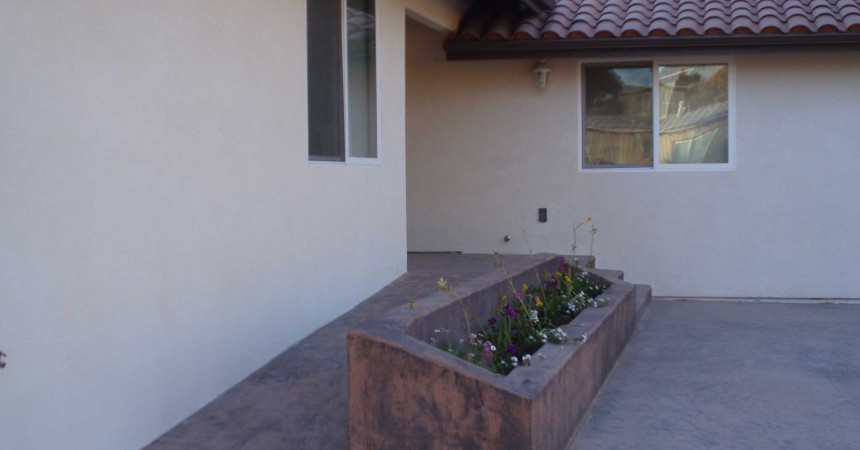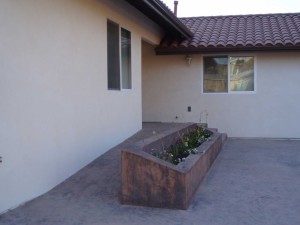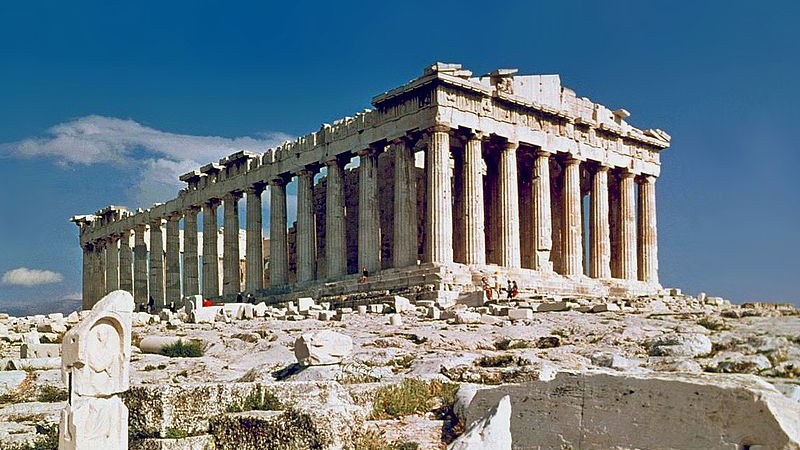
History of Architecture – Ancient Greece
History of Architecture – Ancient Greece
Recently I completed a course in History of Architecture – Arch218 at Cal Poly San Luis Obispo, which I took for professional development as well as an obvious interest in the subject. I loved the class and want to follow up with a blog to help me retain what I learned and share it with others. So if you are interested in joining me, I am setting out to retrace the “course of architectural history!” I will be going back to my lecture notes, text books, and web links to provide a series of blog posts relating to each of the lectures that covers the Middle Ages (~1200 CE) to the Industrial Revolution (~ 1800 CE). My first two posts in this series will look briefly at the Classical eras of Greek and Roman architecture because these two epochs are fundamental to a discussion of subsequent European architectural history. Classic Greek and Roman architecture has influenced many styles including Romanesque, Renaissance, Baroque, and Neoclassical.
Greece was a powerful maritime empire in the Mediterranean in the 6th century BCE when they began to use stone construction. Previously Greeks built mostly wooden and mud-brick structures but became influenced by the monumental stone structures of the Egyptians, who were trade partners. The wealth accumulated by various Greek colonies from trade contributed to the construction of monumental stone temples. Most Greek temples were built in Greek colonies throughout the Mediterranean and beyond, and to a lesser degree in mainland Greece. The decline and eventual end of large Greek temple construction came over the 3rd through 1st centuries BCE as political and economic power shifted toward the Roman Empire.
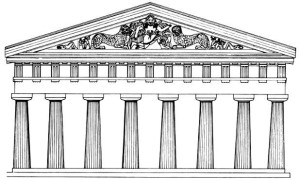
Reconstruction of the west facade of the Temple of Artemis, 600-580 BCE, Korkyra (Corfu)
Photo Credit http://www.mlahanas.de/Greeks/Arts/CorfuArtemis/CorfuTemplePlan.jpg}Image
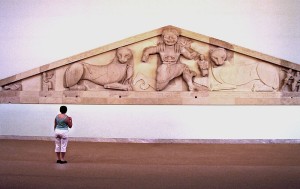
Sculptures from the Pediment of the Temple of Artemis at the Archaeological Museum in Corfu
photo credit: http://en.wikipedia.org/wiki/File:Gorgon_at_the_Archaeological_Museum_in_Corfu.jpg
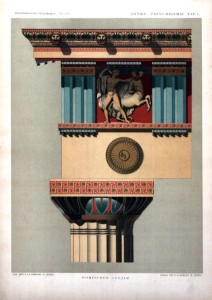
Example of ancient Greek architectural paint scheme. photo credit: http://en.wikipedia.org/wiki/Ancient_Greek_art
The first example of a stone Doric temple (a-la the Parthenon) was the Temple of Artemis at Corfu, 600-580 BCE. This stone temple, now in ruins, had a triangular rooftop called a pediment, supported by the Doric order of columns, architrave, frieze and cornice that became common in Greek and Roman architecture. Although typical images of Greek temples are of monochromatic stone, they had brightly painted details – especially at the frieze. However, centuries of weathering has faded nearly all of the color.
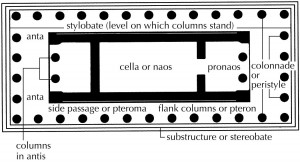
Typical plan for a Greek temple http://www.thewaxtablet.com/2012/02/08/the-ancient-greek-temple-an-introduction-to-architectural-layouts/
The basic elements of the Greek temple floor plan are the naos (central structure housing a statue of the god the temple was built for), the pronaos (front porch extension of the naos), the opisthodomos (back porch extension of the naos), and the peristasis, which is the series of columns surrounding the central structure. One very notable Greek construction technique is the use of optical refinements throughout a temple structure. These refinements included a slight upward curve of the temple base or stylobate, as well as the architrave above. Columns are each shaped with an entasis, or a reduction in diameter as they rise. The columns also tilt slightly inward, especially at the corners, and are spaced slightly closer together at the corners than in the middle of the peristasis. Together these refinements help produce a much more dynamic and stout appearance when compared to more recent Neoclassical or Greek Revival buildings that borrow from Ancient Greece. Compare the British Museum in London with the Parthenon, which may be the best example of Greek optical refinement.
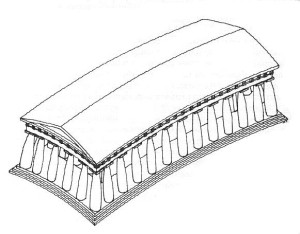
An exaggerated illustration of the Parthenon’s optical refinements. Photo credit: http://en.wikipedia.org/wiki/File:Opticorr.JPG
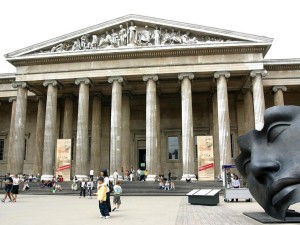
The British Museum, London. The facade is an obvious copy of the Parthenon, but the Greek Revival building appears more stiff and weaker at the columns. Photo credit: http://world-placez.blogspot.com/2013/02/British-Museum-England-Info.html
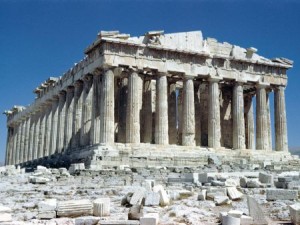
The Parthenon, as rough as it is now, still appears stout. Photo credit: http://archidialog.com/2011/01/16/david-chipperfield-oscar-niemeyer-the-parthenon-conscious-inspiration/
The Parthenon, a temple for the patron goddess Athena, is located on the Acropolis of Athens. Built in the 5th century BCE, it is maybe the most important remaining Classic Greek building and the height of the Doric order. Originally a temple, It has also served as a Greek treasury, a Christian church, an Ottoman mosque, and an Ottoman ammunition depot. Because Greece became a Byzantine (later an Ottoman) territory, it was politically closed to Western Europe for centuries. It was not until the end of the 18th century that the ancient Greek architecture of Athens was “rediscovered” due to a more politically open Ottoman Empire.
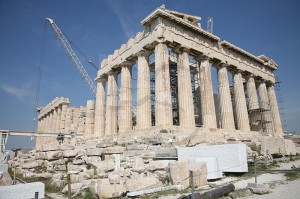
Parthenon restoration. Photo credit: http://www.ronsaari.com/stockImages/greece/AthensParthenon1.php
The Parthenon, 447-32 BCE, is the iconic Greek temple. Unfortunately today it is largely in ruins, although It was a mostly intact until 1687 when it was bombarded by the Venetians. Most of the damage was actually caused by the fact the Ottomans were using the Parthenon as an ammunition depot, which may have been why the building was targeted. The explosion blew the roof off the building and nearly destroyed it completely. More controversy occurred in 1806 when the Ottomans allowed the British ambassador, the Earl of Elgin, to take a majority of the ancient Greek frieze that adorned the top of the Pantheon. Many of those sculptures, known as the Elgin Marbles or Parthenon Marbles, are now displayed in London’s British Museum, but Greece has repeatedly asked for their return and has even built a museum to display them if/when they are returned. A recently completed partial restoration of the Parthenon took over 30 years, using original pieces where possible and new marble (from the original quarry) where needed. It is amazing to think it took less than 9 years to build the original structure (plus a few more years for decoration).
Although ancient Greek architecture heavily influenced Roman architecture, the two styles are different in many ways. The Romans were influence by Greece as well as other ancient peoples, but used their own building types, spaces and forms to reflect their civic-oriented culture and city planning. Thank you for reading and please come back soon for my next post in this series on ancient Roman architecture. In the mean time check out this terrific Nova episode “Secrets of the Parthenon” and this Chicago Tribune photo gallery of the restoration.

